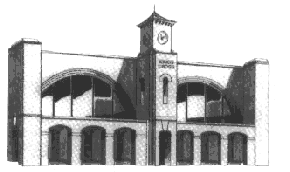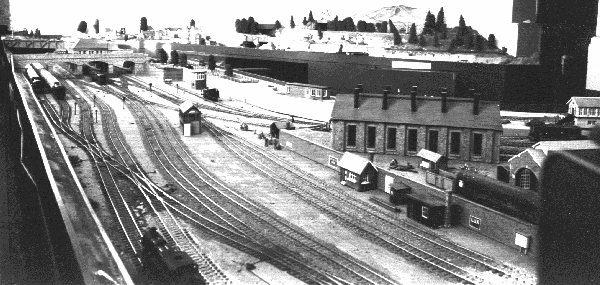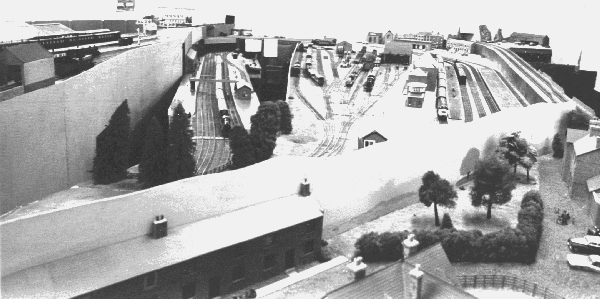

Founded in 1946
UK Registered Charity No. 1042534
Member of the 'O' Gauge Guild
Setting the Scene
Gainsborough is a place which is remembered as the site of the headquarters of the Danish Kings Sweyn and Canute one thousand years ago; the site of a battle during the Civil War; the home of Gainsborough Old Hall (one of the finest and most complete timber framed medieval manor houses surviving in England); or merely just a small inland port on the River Trent, 60 miles from the sea, set in the flat green Lincolnshire countryside from which the once familiar passenger trains hauled by steam locomotives, and the long loose coupled clanking goods trains with their motley assortment of wagons have sadly long since disappeared.
Gainsborough is however still a place where the nostalgic scene of the heyday of steam railways may be recaptured by visiting the world-famous Gauge 'O' (7mm to 1 foot) Railway of the Gainsborough Model Railway Society. It should not be confused with the many model railways found at seaside, or stately homes, with a host of trains speeding incessantly and monotonously around a series of oval tracks.
 London's "King Cross Station" |
This is an end to end Railway based on the ex-LNER East Coast Main Line between Kings Cross and Leeds Central, and occupies more than 2500 square feet, with more than half a mile of track. Lack of space, of course, precludes the inclusion of all 61 stations which existed between the two termini, but our model still incorporates nine passenger stations, three goods yards and five locomotive depots. Modellers' licence has been used in the building of most of these, but Kings Cross Station with its twin arched roof and frontage, and Leeds Central Station are immediately recognisable, having been built to the same scale dimensions as the originals. |
Operation
Ever since the Society's formation in 1946, it has taken most pride in the fact that it is run, as far as possible, in all aspects, in a full scale railway like manner as possible, ranging from the building of the track and scenery, locomotives and rolling stock, to the actual operation of the line, in accordance with the practices of British Railways and its LNER predecessor.
It is this that led the County Museum Service to recognise and publicise the Society as a "Working Museum" because it is "from a museum point of view an excellent example of a living piece of history, which helps to give the visitor a real understanding of what it was like to run a main-line railway".
Below: General view of 'Doncaster Station', with 'Fitzwilliam Station' in the immediate foreground 
Above: The down line approach to 'Hadley Wood'

The cornerstone of the operation of the Railway is the timetable, which is produced using the time-honoured graph paper, in the same manner as was used by British Railways before the introduction of computers. The safe and effective running of the trains is ensured, as it was (and still is) on the LNER and BR by division of the track into 10 block sections, each controlled by a signalman (operator) using the authentic BR system of bell codes to request and give authorisation into and out of each block section according to the timetable, as on the real railway. Some sections are controlled by colour light signals, others by semaphore signals, either original lattice somersault, or later upper-quadrant types. Some seven to twelve minutes are taken for trains to pass between the two termini.
Locomotives
More than 100 locomotives are avaiable for our use, all being fine scale models hand built by members or associates of the Society, many to drawings supplied by British Rail, some painted in LNER or earlier liveries, some in their
BR hue. They are mostly representatives of the major classes of the LNER and its pre-1923 constituent companies (GNR, GCR, GER and NER) and its BR successor. There are also a few representatives of other pre-BR companies, such as ex-GWR "Pendennis Castle", ex-LMS "Duchess of Hamilton" and ex-Southern "Clan Line". A number of famous preserved steam locomotives are also represented, including GNR No.1 the famous Stirling Single Wheeler which took part in the "Race to the North" in 1880, the two GNR Atlantic's of the National Railway Museum, four A4 s, (the same class as the speed record holder for steam "Mallard") and world famous 4472 "Flying Scotsman", which epitomises the glory of steam in its hey day. She was saved from the scrap heap by the Society's president Alan Pegler - the saviour of steam on British Rail, and was a familiar sight in the 1960s hauling the Society's excursions.

Small boilered Atlantic No. 990 (1898)
This locomotive, designed by H.A. Ivatt, was the first British Atlantic 4-4-2. Fitted with what would later be considered a small boiler with narrow firebox, it was nevertheless, a large engine for its time and gave the Great Northern Railway a boost in power and speed. When withdrawn in 1937, it had covered approximatly 1,296,000 miles.
The prototype of No. 990 is preserved at the National Railway Museum.
Rolling Stock
The passenger coaching stock is also hand built, and is formed into 8 coach set formations of various representative types, including the original GNR/LNER teak bodied sets, the LNER blue "West Riding", an LNER "Tourist" Set in green and cream, as well as maroon and "blood and custard" sets of the nationalised era.
 |
Newton Coach Corridor 3rd No. E1617E This was the prototype laminated card coach built by Don Handley in 1950. It was originally fitted with Rockey Precision Bogies, which had to be replaced several years ago. It is now on its third set of wheels ! |
Society 'Open Days'
Each year the Society organises a number of 'Open Days' to enable the public to view the Railway in full operation and experience the nostelgia of the former years. 'Open Days' are arranged over the Easter and late Summer Bank Holidays, and at Christmas.
| July - | Sunday 6th July Sunday 27th July |
1.30 pm to 6 pm 1.30 pm to 6 pm |
| Late Summer Bank Holiday - | Saturday 23rd August Sunday 24th August Monday 25th August |
1.30 pm to 6 pm 1.30 pm to 6 pm 10.30 am to 6 pm |
| Christmas - | Sunday 7th December Saturday 27th December Sunday 28th December |
1.30 pm to 6 pm 1.30 pm to 6 pm 1.30 pm to 6 pm |
The Society is located at Florence Terrace, Gainsborough, Lincolnshire, about 100 yards from the 'Trinity Centre Car Park' which is sign posted from the A159 and other routes.
Well appointed toilet and light refreshment facilities are available to Visitors.
For further information or to arrange a visit please telephone:
 |
01427 615871 |  |
Departure
Gainsborough Model Railway Society is a member of the:

Where are you going now?
[ Previous Site | Go to a Random Site | Next Site ]
[ List the Next 5 Sites | List all Member Sites ]
Direct links to other Gauge 'O' Guild Sites:
Gauge 'O' Guild (Central Southern Group)
Gauge 'O' Guild (West Cheshire & North Wales Group)
![]()
You are visitor No